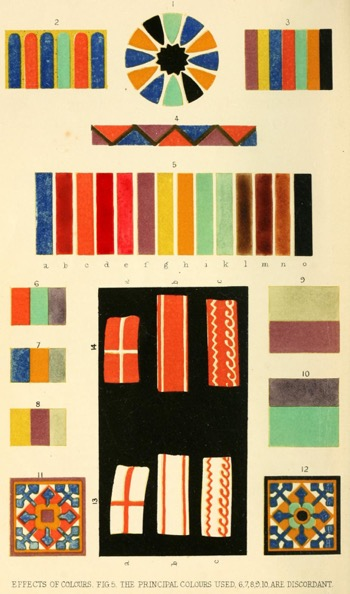
On Colour and Taste: John Gardner Wilkinson and Werner’s Nomenclature of Colours
Colour Materiality
1858
The English Egyptologist, author and chromophile John Gardner Wilkinson (1797–1875) fostered a particular interest in the agency of colour as an arbiter of taste. In preparation for his 1858 treatise On Colour and on the Necessity for a General Diffusion of Taste Among all Classes, Gardner Wilkinson perused the pages of a number of publications whose subject-matter was chromatic. The earliest of these was an 1821 edition of Werner’s Nomenclature of Colours by Patrick Syme. Syme’s publication contained a catalogue of the 110 most commonly-occurring colours in the natural world, arranged in ten charts. Its purpose was to provide a standard vocabulary of colours, with swatches of watercolour and written examples from the ‘Animal’, ‘Vegetable’ and ‘Mineral’ kingdoms. Syme’s terms included Orpiment Orange, Flax-Flower Blue and Arterial Blood Red. In his introduction Syme promised that regular interaction with the book’s charts would improve the colour sense of his readers, cultivating a ‘general knowledge of colours’ and rendering ‘the eye, by practice […] correct’ (Syme, p. 13).
While Wilkinson was also concerned with improving the discerning faculties of his readers, his purpose in writing On Colour and on the Necessity for a General Diffusion of Taste was to define the chromatic parameters of good taste and bad. Wilkinson believed that a knowledge of ‘the harmonious arrangement of colours’ could guard against the decorative application of ‘discordant’ or ‘anomalous’ hues (p. 1). Echoing Syme, Wilkinson asserted that ‘[t]he harmony of colour must first be learnt through the eye’, and that ‘the perceptive faculties may be improved or misled by the frequent contemplation of perfect or imperfect models’ (p. 4). Wilkinson’s plates provide archetypal examples of chromatic harmony, including those drawn from Italian mosaics, Egyptian arrangements and Eastern carpets.
Wilkinson’s figures also include a colour chart, comparatively succinct, set out in a small horizontal scale of chromo-lithographed rectangles and finished with washes of watercolour applied by hand. It comprises only those colours commonly required for decorative purposes: ‘viz. a. blue, b. red, c. scarlet, d. crimson, e. cerise, f. purple, g. yellow, h. orange, i. green, k. tea-green, l. brown, m. horsechesnut, n. chesnut, o. black’ (p. xii). For the taxonomy of colour, Wilkinson directs his readers to ‘a very useful work on the subject (“Werner’s Nomenclature of Colours”), where he will find a great number of them treated in a very practical manner, with their hues illustrated by references to objects in the animal, vegetable, and mineral world’ (p. 91). Wilkinson’s personal copy of Syme’s colour manual survives, and can be found in the library of Calke Abbey, Derbyshire.
Bibliography
-
Syme, Patrick, Werner's Nomenclature of Colours: with Additions, Arranged so as to Render It Highly Useful to the Arts and Sciences, Particularly Zoology, Botany, Chemistry, Mineralogy, and Morbid Anatomy; Annexed to Which Are Examples Selected from Well-Known Objects in the Animal, Vegetable, and Mineral Kingdoms, Edinburgh: William Blackwood, 1821.
-
Wilkinson, John Gardner, On Colour and on the Necessity for a General Diffusion of Taste Among All Classes, London: John Murray, 1858. https://archive.org/details/oncolouronnecess00wilk/mode/2up